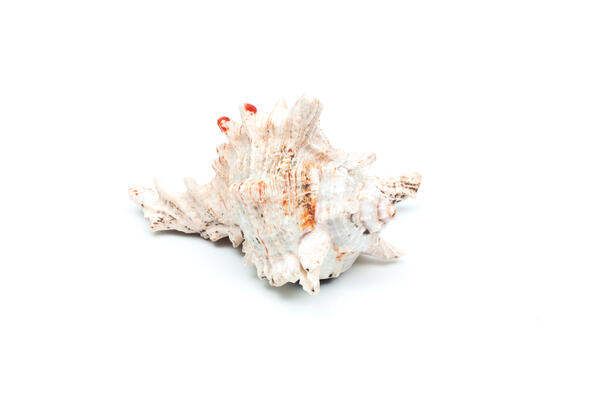This shell of a murex sea snail belonged to Ivan Goncharov. The writer brought it home from his trip during 1852–1855 when he traveled on board the Pallada frigate. The shell was most likely bought on one of the markets in Java or Singapore, which Goncharov described in his book of essays “Frigate “Pallada”,
Murex
Время создания
the mid-19th century
Место создания
Indian Ocean
Размер
11,5x9x7,5 cm
Техника
natural material
Коллекция
Выставка
#3
Murex
#5
#6
…Cosmopolitan guests spread out their wares, and everyone shouted in his own language, offering cloth, shells, monkeys, birds, coral. I bought a shell, and then some other trinket too, meanwhile observing the new faces surrounding me.
#2
According to a family legend, Goncharov gave this shell to his distant relative Pavel Rudolph in 1855, when the writer paid a brief visit to his native town of Simbirsk after the trip.
In 1990, the shell was donated to the museum by Pavel Rudolph’s grand-granddaughter Natalya Madonova.
Murexes, or sea snails are some of the most well-k nown mollusks in the world. The word murex was used by Aristotle in reference to these kinds of snails, thus making it one of the oldest classical seashell names still in use by the scientific community. There are over 1,600 species of murexes, all different from one another.
Murexes have an intricately shaped shell, all highly sculptured in folds, frills, fronds, spines, ribs, and thorns, which appear due to the slow, but constant growth of the seashells. Such shells can often be found in various collections, as well as serve as a gift or an interior decoration.
The seashell, that Ivan Goncharov brought to Russia, most likely belonged to the biggest murex species — ramose murex. The external shell is white, interspersed with yellow and brown, while the internal is smooth and pink.
In antiquity, murexes were used to make purple fabric dye: a special substance was extracted from the murex’s gland and exposed to the sunlight to turn either purple or red. This dye was considered very expensive, and the right to dress in purple was controlled by legislation. In Ancient Rome, for example, only emperors had the privilege of wearing this color.
In 1990, the shell was donated to the museum by Pavel Rudolph’s grand-granddaughter Natalya Madonova.
Murexes, or sea snails are some of the most well-k nown mollusks in the world. The word murex was used by Aristotle in reference to these kinds of snails, thus making it one of the oldest classical seashell names still in use by the scientific community. There are over 1,600 species of murexes, all different from one another.
Murexes have an intricately shaped shell, all highly sculptured in folds, frills, fronds, spines, ribs, and thorns, which appear due to the slow, but constant growth of the seashells. Such shells can often be found in various collections, as well as serve as a gift or an interior decoration.
The seashell, that Ivan Goncharov brought to Russia, most likely belonged to the biggest murex species — ramose murex. The external shell is white, interspersed with yellow and brown, while the internal is smooth and pink.
In antiquity, murexes were used to make purple fabric dye: a special substance was extracted from the murex’s gland and exposed to the sunlight to turn either purple or red. This dye was considered very expensive, and the right to dress in purple was controlled by legislation. In Ancient Rome, for example, only emperors had the privilege of wearing this color.
#4
Ministry of Culture of the Russian Federation
читать дальшескрыть
00:00
00:00
1x
Murex
Время создания
the mid-19th century
Место создания
Indian Ocean
Размер
11,5x9x7,5 cm
Техника
natural material
Коллекция
Выставка
Открыть в приложении
Поделиться



